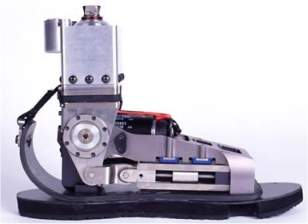Pé robótico é a mais avançada prótese já criada
Cientistas do MIT, Estados Unidos, criaram um novo pé-robótico que é a mais avançada prótese do seu tipo já apresentada. Além de maior conforto, o novo equipamento dá ao seu portador uma forma natural de andar.
Pé robóticoO novo pé robótico utiliza um sistema de molas acionado por um motor que imita o funcionamento dos tendões do pé. O principal benefício é o menor cansaço do usuário que utiliza a prótese. Mas o amputado passa a ter também um melhor equilíbrio e apresenta um andar natural, sem o mancar comumente apresentado por usuários das próteses tradicionais.
"Esse design libera três vezes a potência de uma prótese convencional para impulsionar você para a frente e, pela primeira vez, dá aos amputados um modo de caminhar verdadeiramente humano," diz o professor Hugh Herr, ele próprio um amputado, que está testando sua própria invenção.
Prótese ativaAs próteses naturais, por não serem ativas, exigem até 30% a mais de energia no andar. Já a nova prótese robótica armazena a energia produzida pela pessoa ao se projetar para a frente no ato de caminhar. Essa energia é então liberada quando quando o corpo já se move para uma posição à frente do pé, impulsionando a pessoa.
Esse mecanismo é constituído por um conjunto de molas e por um pequeno motor elétrico, alimentado por uma bateria recarregável. Os pesquisadores foram cuidadosos ao tentar reduzir ao máximo o volume e o peso da prótese: o resultado é um pé robótico leve e flexível e que já poderá chegar ao mercado no próximo ano.
ImplantesMas o Dr. Herr não planeja encerrar suas pesquisas nesta primeira versão do pé-robótico. No próximo ano ele planeja receber pequenos implantes sem fios nos músculos próximos às suas junções neuromusculares. Quando seu músculo se contrair, o impulso elétrico irá enviar informações precisas para controlar a prótese robótica.
E, mais a longo prazo, ele planeja pesquisar a possibilidade de unir mecanicamente a prótese aos ossos restantes na perna das pessas amputadas. Isso permitirá transferir a carga diretamente para a estrutura óssea do paciente, eliminando qualquer desconforto ainda causado pelo uso da prótese robótica.
http://www.inovacaotecnologica.com.br/noticias/noticia.php?artigo=010180070727